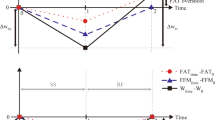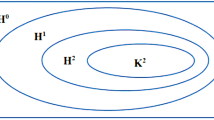Abstract
A mathematical model has been developed to facilitate indirect measurements of difficult to measure variables of the human energy metabolism on a daily basis. The model performs recursive system identification of the parameters of the metabolic model of the human energy metabolism using the law of conservation of energy and principle of indirect calorimetry. Self-adaptive models of the utilized energy intake prediction, macronutrient oxidation rates, and daily body composition changes were created utilizing Kalman filter and the nominal trajectory methods. The accuracy of the models was tested in a simulation study utilizing data from the Minnesota starvation and overfeeding study. With biweekly macronutrient intake measurements, the average prediction error of the utilized carbohydrate intake was −23.2 ± 53.8 kcal/day, fat intake was 11.0 ± 72.3 kcal/day, and protein was 3.7 ± 16.3 kcal/day. The fat and fat-free mass changes were estimated with an error of 0.44 ± 1.16 g/day for fat and −2.6 ± 64.98 g/day for fat-free mass. The daily metabolized macronutrient energy intake and/or daily macronutrient oxidation rate and the daily body composition change from directly measured serial data are optimally predicted with a self-adaptive model with Kalman filter that uses recursive system identification.


Similar content being viewed by others
References
Anderson B, Moore JB (2005) Optimal filtering. Dover Publications, New York
Bousbiat S, Jaffrin MY, Dongmo E (2011) Comparison of body fat-free masses calculated from hand-to-foot and foot-to-foot resistances with DXA measurements. Med Biol Eng Comput 49:1329–1336. doi:10.1007/s11517-011-0827-y
Bousbiat S, Jaffrin M, Assadi I (2015) Factors influencing accuracy and reproducibility of body resistance measurements by foot-to-foot impedancemeters. J Med Eng Technol 39(1):35–43. doi:10.3109/03091902.2014.973617
Cunningham JJ (1990) Calculation of energy expenditure from indirect calorimetry: assessment of the Weir equation. Nutrition 6(3):222–223
Elia M, Livesey G (1988) Theory and validity of indirect calorimetry during net lipid synthesis. Am J Clin Nutr 47(4):591–607
Ferrannini E (1988) The theoretical bases of indirect calorimetry: a review. Metabolism 37(3):287–301. doi:10.1016/0026-0495(88)901
Grewal MS, Andrews AP (2008) Kalman filtering: theory and practice using MATLAB, 3rd edn. Wiley, New Jersey
Hall KD (2006) Computational model of in vivo human energy metabolism during semistarvation and refeeding. Am J Physiol-Endocrinol Metab 291(1):E23–E37. doi:10.1152/ajpendo.00523.2005
Hall KD (2010) Mechanisms of metabolic fuel selections. IEEE Eng Med Biol Mag 28(1):36–41. doi:10.1109/MEMB.2009.935465
Hall KD (2010) Predicting metabolic adaptation, body weight change, and energy intake in humans. Am J Physiol-Endocrinol Metab 298(3):E449–E466. doi:10.1152/ajpendo.00559.2009
Hall KD (2013) Mathematical modeling of metabolism and body weight regulation. In: National Institute of diabetes and digestive and kidney diseases web (NIDDK). http://www2.niddk.nih.gov/NIDDKLabs/LBM/LBMHall.htm. Accessed 2013
Hebert JR, Allison DB, Archer E, Lavie CJ, Blair SN (2013) Scientific decision making, policy decisions and the obesity pandemic. Mayo Clin Proc 88(6):593–604
Hebert JR, Ebbeling CB, Matthews CE, Hurley TG, Ma Y, Druker S, Clemow L (2002) Systematic errors in middle-aged women’s estimates of energy intake: comparing three self-report measures to total energy expenditure from doubly labeled water. Ann Epidemiol 12(8):577–586
Jaffrin MY, Morel H (2008) Body fluid volumes measurements by impedance: a review of bioimpedance spectroscopy (BIS) and bioimpedance analysis (BIA). Med Eng Phys 30:1257–1269. doi:10.1016/j.medengphy.2008.06.009
Jazwinski AW (1970) Stochastic processes and filtering theory. Academic Press Inc, New York
Keys A, Brožek J, Henschel A, Mickelsen O, Taylor HL (1950) The biology of human starvation. University of Minnesota Press, Minneapolis
Levi J, Segal L, Rayburn J, Martin A (2015) Obesity rates and trends overview. In: The state of obesity. National Center for Health Statistics Health E-Stat 2014. http://stateofobesity.org/obesity-rates-trends-overview/. Accessed May 2015
Ljung L, Söderström T (1983) Theory and practice of recursive identification. MIT Press, Cambridge
Ori Z, Ori I (2015) Self-directed weight management by feedback from a self-adaptive metabolic health monitoring system. Self-adaptive and self-organizing systems (SASO), 2015 IEEE 9th international conference on. doi:10.1109/SASO.2015.28
Schutz Y (2004) Concept of fat balance in human obesity revisited with particular reference to de novo lipogenesis. Int J Obes Relat Disord 28(S4):S3–S11
Simonson DC, DeFronzo RA (1990) Indirect calorimetry: methodological and interpretative problems. Am J Physiol-Endocrinol Metab 258(3):E399–E412
Walter E, Pronzato L (1997) Identification of parametric models from experimental data. Springer, Berlin. doi:10.1109/TAC.1999.811220
Weir JB (1949) New methods for calculating metabolic rates with special reference to protein metabolism. J Physiol 109:1–9
Author information
Authors and Affiliations
Corresponding author
Electronic supplementary material
Below is the link to the electronic supplementary material.
Rights and permissions
About this article
Cite this article
Őri, Z.P. Parametric recursive system identification and self-adaptive modeling of the human energy metabolism for adaptive control of fat weight. Med Biol Eng Comput 55, 759–767 (2017). https://doi.org/10.1007/s11517-016-1552-3
Received:
Accepted:
Published:
Issue Date:
DOI: https://doi.org/10.1007/s11517-016-1552-3




